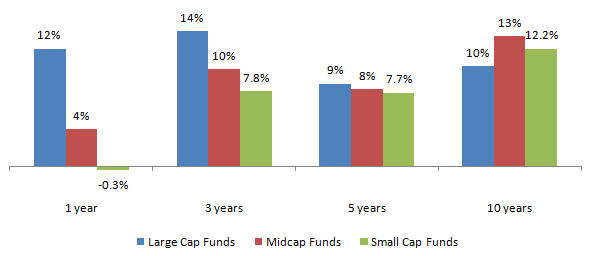What are Mid and Small cap mutual fund investing myths

The last 2 years have been difficult for mid and small cap stocks and funds. Nifty Midcap 100 index has fallen nearly 20% in last 2 years, while the Nifty Small Cap 100 index has fallen 37%. 2019 was a relatively better year for small and midcaps, even though we saw negative returns for both midcap and small cap indices in 2019 as well. While the year 2018 and 2019 have been bad for midcaps, the last 5 years preceding 2018 i.e. 2013 to 2018 saw Nifty Midcap 100 index giving 20% CAGR returns. Midcap and small cap funds were among the most favoured mutual fund schemes during that period, which is typical bull market behaviour.
Retail investor’s attitude towards some investments is often shaped by myths or incorrect perceptions, which results in investors making wrong investment decision. In this blog post, we will look at some common investing myths about the midcap and small cap mutual funds.
Myth 1: Midcap and small cap mutual funds are very risky
Generally, we can say that individual midcap and small cap stocks are riskier than the large caps stocks because large cap companies enjoy the advantage of larger market share and balance sheets, which puts them in an advantageous position to survive economic downturns. However, there are many midcap companies which have robust business models which are not capital intensive, have track record of delivering free-cash flows and high return on equity (ROE). These companies have higher growth potential than their large cap counterparts due to their smaller size. Good fund managers are able to identify such stocks and invest in it for the long term. Further, midcap and small cap mutual funds diversify stock and sector specific risks by investing in a portfolio of stocks across different sectors.
The risk of individual midcap and small stocks cannot be equated with risk of midcap or small cap mutual funds.
It is fair to say that, midcap and small cap funds are more volatile than large cap funds. Many investors tend to equate volatility with risk, but in our view these are two distinct concepts. Volatility is the daily Net Asset Value (NAV) or price fluctuation of a fund. Prices can go up or down – volatility does not distinguish between upward and downward price movement, though sharp falls can understandably be stressful for investors. Risk in our view, is the probability of making a loss. Investors should understand that they will make a loss only if they redeem (sell) – if you are holding your investment, then all profits or losses are notional. Therefore it is very important to understand, risk is tied to the investment tenure of the investor. Longer your investment tenure in equity mutual funds, lower is the risk irrespective of interim volatility. We recommend that investors should have at least 3 to 5 years of investment horizon for equity mutual funds – longer the better.
Suggested reading: Should you invest in midcap mutual funds now
Finally the risk of making a loss in the short to medium term is always related to price level at which you buy. If you are investing in an asset after price has gone up 40 - 50% or more, the chances of making a big loss in the short to medium term is much higher. On the other hand, if you are investing when prices have fallen 20 – 30%, then chances of making a big loss is that much lower in the short to medium term.
Myth 2: Mid and Small Caps are of inferior quality compared to large caps
Many investors believe that small and midcap stocks are of inferior quality; many think that they are for speculative investments and not for long term buy and hold. It is true that large cap companies have larger market share, higher revenues / profits (earnings per share) and greater financial strength.That’s why some financial advisors suggest to have large cap funds as the core of your portfolio – You may read this: Why should large cap funds form the core of your portfolio
However in our view, while investors care about risks, they are also willing to take some risk for higher capital appreciation; bigger balance sheets do not necessarily imply more capital appreciation for investors.
Investors should remember that the three important drivers of long term capital appreciation are:-
- Earnings Per Share (EPS) growth quality
- Sustainability of EPS growth; Return on Equity (ROE) is the most important factor in sustainability of EPS growth
- Valuation or the price at which you invested
For the first two factors mentioned above, fund managers look at Free Cash Flows and Return on Equity or Return on Capital Employed. They also look at the business model and quality of management (standards of corporate governance, accounting policies, track record of taking care of minority shareholder interests etc). To get a better qualitative sense of business model and management, fund managers visit factories and meet with the management.
Ordinary individual investors will not have access to such information but good mid and small cap fund managers are able to identify quality stocks. That is why, over the last 10 years, despite several bear markets which affect small/midcaps the most, midcap and small cap funds as categories were able to deliver 2 to 3.3% higher average CAGR returns compared large cap funds – Please see the chart below.

Over the last 10 years, midcap and small cap funds were able to beat more diversified equity fund categories like multi-cap funds and large & midcap funds as well (please see our Mutual Fund Category Monitor). This disproves the notion that midcap and small cap stocks are of inferior quality because superior long term performance cannot be sustained with inferior quality.
Large cap companies tend to be more capital intensive, rely on debt financing and therefore,have high debt to equity ratios. This causes these companies to have high interest burden which eats into their profit margins and ROCE. Midcap and small cap companies tend to have less capital intensive business models and lower financial leverage (debt equity ratio). While this may cause mid and small cap companies to be size limited in the near to medium term, in the longer term, this works as an advantage for midcap and small cap companies and they are able to generate higher profit margins and ROCE.
Finally on a historical basis, large caps usually trade at a premium to midcap valuations. The midcap rally from 2014 to 2018 caused small / midcap valuations to be over stretched and created an abnormal situation which warranted a major correction. The correction in the last two years along with earnings growth recovery,of which we are seeing some early signs, will have a beneficial impact on valuations.
Investing in midcaps has higher growth potential and eventually these midcaps and small caps can fetch higher returns for investors during valuation re-rating along with EPS growth.
Myth 3: Mid and small caps are not good because they give lower dividend yields
In the US lot of attention is paid to dividend yields – investors there love high dividend yields. Some investment bloggers in India simply parrot what they read / hear in Western journals and podcasts. We have mentioned a number of times in our blog that, you should always invest according to your needs. You should invest in high dividend paying stocks if you need income on a regular basis (in the form of dividends). However, there are some investors (and also so called investment experts) who think that high dividend yield stocks are better. High dividend yield stocks might be more stable from a price volatility viewpoint, but they will not necessarily give superior total returns in the long term.
You should understand the rationale behind dividends. Dividends are paid out of Profit after Tax (PAT). The company’s management has two options with regards to what to do with the PAT.
- Distribute profits to investors (shareholders) as dividends
- Retain profits in the company and re-invest for business growth (revenue growth)
- A combination of the above two – how much to payout as dividends and how much to retain will depend on the management’s outlook, depending on what is best for the shareholder’s interests
Most companies (including those in US and other developed markets) go for option 3. Very mature companies in the developed markets distribute a large percentage of their net profits as dividends because growth opportunities are limited for such matured companies / sectors. PAT belongs to shareholders of the companies and these companies (which have high dividend yields and limited growth opportunities) believe that shareholders are best placed to decide what to do with the money.
On the other hand, management may decide that it is in the best interest of shareholders of the company, if the company re-invests its profits in growth opportunities which can give high returns in future. If you look at some of the fastest growing companies in the US like Amazon and Google, they have not paid any dividends since their respective IPOs. Profit re-investment for business growth is even more relevant in India because we are one of the fastest growing economies in the world and many equity investors want to be a part of this growth story. Instead of paying large dividends, which benefits large shareholders the most, if companies reinvest their profits in growth opportunities then all shareholders will benefit by way of capital appreciation in the long term.
This is especially relevant in the context of midcap and small cap companies where growth potential is huge. Further, dividend is not a very tax efficient way of getting returns. The company has to pay dividend distribution tax (@ 15%) before declaring dividends to investors. Further, if dividends exceed Rs 10 lakhs in a year, then the investor has to pay 10% dividend tax. Long term capital gain, on the other hand, is much more tax efficient way of generating returns.
Indian investors looking for long term capital appreciation and wealth creation should not be enamoured by dividend yield and instead look at their long term financial goals.
High quality mid and small cap companies have successfully grown their businesses over time and delivered superior total returns to investors in the long term. One of my investment gurus used to tell me that investors should look at absolute returns over their investment horizon, especially for midcaps and small caps, because absolute returns matter in the long term.
Myth 4: It is better to buy multi-bagger midcap stocks directly in the stock market
The biggest multi-bagger stocks usually come from midcap and small cap market segments. Multi-bagger stocks are the ones which give more than 100% returns over 2 – 3 years or less. One of my friends said to me why not put a substantial part of his risk capital in these multi-bagger stocks (as recommended by his stockbroker or stock analysts) instead of investing in midcap or small cap mutual funds, which spreads risks across a large number of stocks.
The reality is that it is very difficult to spot multi-baggers early on – most people come to know about it when prices have doubled or tripled. Retail investors are rarely able to identify these stocks at the right price; investors come to know of multi-bagger stocks only after they have given multi-bagger returns and return potential going forward for such stocks is limited.
It is also unwise to invest in stocks, especially midcaps and small caps, based on market grapevine and rumours because these stocks tend to be under-researched. Many high flying midcap stocks in 2007 are trading even now below 2007 peak levels and destroyed a huge amount of investor’s wealth. Equity investing is about buying the right stock at the right price.
As discussed earlier, mutual fund managers have experience and expertise to identify such stocks – it is prudent to stick to mutual funds for midcap and small cap investing, instead of speculating in midcap or small cap stocks.
Myth 5: Investing in Mid and Small Caps is all about timing
Mid and small cap mutualfunds tend to outperform in bull markets and underperform in bear markets or volatile markets. Therefore, you may want to sell at the bull market peak and buy at the bear market bottom. But in reality, it is next to impossible to time the market while investing. Even experienced investors are unable to time the market. It is very common to come across situations when people end up buying when prices have run up in bull market and selling it at a low price in bear market.
Instead, an investor should follow a systematic approach to investing instead of trying to time the market movements, which will help them tide through volatility and get better returns in the longer term. If you continue to invest through systematic investment plan (SIP) even in bear markets, then you are likely to get much higher returns compared to what you will get by employing a tactical approach based on trying to figure out inflexion points in the market.
You must read: Why continue with SIPs even in higher market
We believe that, despite difficult market conditions over the last 2 years, investors who remained disciplined and continued their SIP over the last 2 years and will do so going forward as well, will be well rewarded in the next 5 years or so.
While we maintain that SIP is the best strategy for investing in midcap and small cap funds, you can also take advantage of deep market corrections to tactically invest in lump sum with long investment horizons. Alternatively, you can also invest in small and midcaps through the STP route.
In this context read how mutual fund systematic transfer plan help invest in volatile markets
Trying to time the market is futile – a disciplined approach and most importantly, long investment horizon (7 – 10 years plus in the case of small / midcaps) is the best recipe for wealth creation.
Summary
Midcap and small cap equity mutual funds are more volatile than large cap equity mutual funds. If you do not have sufficiently high risk appetites then large cap equity mutual funds are more suitable investments option for you.
On the other hand, if you have high risk appetite and long investment tenures then midcap and small cap equity mutual funds can give you the much needed alpha boost to you portfolios and higher returns in the long term. Relative performance trajectories of different market cap segments differ in different market conditions; market behaviour cannot be predicted and so it is difficult to predict when the market will favour large-cap or midcap and small-cap stocks. Instead investors should be prudent to include a mix of different categories of fund in the right proportion as per their risk appetites in their investment portfolios. You should always consult with your financial advisors before investing.
Mutual Fund Investments are subject to market risk, read all scheme related documents carefully.
RECOMMENDED READS
The information being provided under this section 'Investor Education' is for the sole purpose of creating awareness about Mutual Funds and for their understanding, in general. The views being expressed only constitute opinions and therefore cannot be considered as guidelines, recommendations or as a professional guide for the readers. Before making any investments, the readers are advised to seek independent professional advice, verify the contents in order to arrive at an informed investment decision.
Mutual Fund investments are subject to market risks, read all scheme related documents carefully.
Quick Links
Follow Nippon India MF
More About Nippon India MF
POST A QUERY






